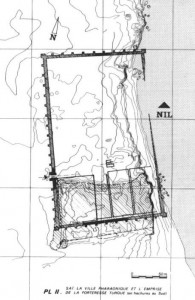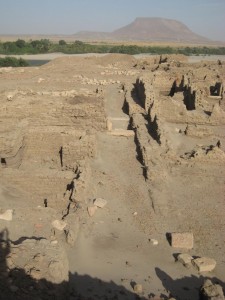Temple towns, also known as fortified towns, are a special phenomenon according to studies dealing with settlement patterns and urbanism in ancient Nubia during the New Kingdom. In most cases the published works in question are general overviews, introductions or entries in encyclopediae concerning the archaeology of ancient Egypt. Following these studies, Egyptian stone temples as well as enclosure walls were major features of New Kingdom settlements in Nubia, like Sai Island. Because of these two major elements such sites are typically called temple towns or fortified towns (e.g. Heidorn 1999; Welsby 2001; Bard 2007; for actual fortresses and military bases in New Kingdom Egypt see Morris 2005).
Kemp was one of the very first scholars, who dealt with these special settlement structures and presented the then almost generally accepted model of how a fortified town in Nubia has to look like (Kemp 1972a). The design of the towns is assumed to have been fairly uniform and they were enclosed with a mud brick wall as a rule. The internal structure was basically dominated by three types of building: a stone temple of characteristic Egyptian design as well as domestic and administrative mud brick buildings, including the civil government residence (Kemp 1972a: 653). As references Kemp cited only the settlements at Amara West and Sesebi, reflecting the restricted state of knowledge and publication back in the 1970ties.
At present, we know much more about settlements and towns founded or being reoccupied in the New Kingdom in Nubia – all of which received the designation of a temple town. Most probably the labelling is solely based on the existence of a temple. None of the authors seem to respect the other features postulated by Kemp. Furthermore, from the published works, it is impossible to say how many of these sites have been labelled as a temple town, as the opinions range from only three temple towns (Welsby 2001, Bard 2007) to 28 (Zibelius-Chen 2013)! Another contentious issue is the motivation for its development: was this due to political and religious factors (as proposed, e.g. by Morkot 1993, 2001; Spence 2004; Bard 2007 and Zibelius-Chen 2013) or to purely economical ones (Trigger 1965; Kemp 1972a, 1972b; Heidorn 1999)?
As one can see there is much potential for a new consideration of the topic of the so-called temple towns starting with a fresh evaluation of Kemps model from 1972 considering the current state of research to the general question how a city or town has to look like for the Egyptians in Egypt and in turn in Nubia (the so-called town problem, e.g. Bietak 1979). Special attention has also to be given to the question whether some or even all of the refurbished and reoccupied Middle Kingdom-fortresses have been taken into account speaking about New Kingdom temple towns, like obviously Zibelius-Chen is doing (Zibelius-Chen 2013).
Especially Sai Island is one of the most interesting settlements among the potential temple towns or fortified towns as it was the first newly established town founded most probably by Ahmose. With all of its strategic advantages, Sai served as a bridgehead during the further expansion into Nubia (Davies 2005). As recent fieldwork has clearly illustrated, we are far away from understanding the complete layout and development of the New Kingdom town of Sai. How did the very early town founded by the Egyptians look like? Was there a predecessor for the Egyptian Amun temple built by Thutmose III? All of these questions are currently investigated by AcrossBorders.
Thus Sai fits perfectly into my envisaged PhD-Thesis at Humboldt-University Berlin briefly summarized here and I am very happy and grateful to Julia Budka, not only for her supervision of my PhD, but also for giving me the great opportunity to work as a PhD-researcher in her fantastic project. I am very pleased to have joined the AcrossBorders team!
References
Bard, Kathryn A. 2007. An introduction to the archaeology of Ancient Egypt. Malden, Mass: Blackwell Publ.
Bietak, Manfred 1979. Urban archaeology and the ‘town problem’ in ancient Egypt, in: Kent R. Weeks (eds.), Egyptology and the social sciences. 5 studies. Cairo: American Univ. in Cairo Press. 97–144.
Davies, Vivian W. 2005. Egypt and Nubia. Conflict with the Kingdom of Kush, in: Catharine H. Roehrig (ed.), Hatshepsut: From Queen to Pharaoh. New York, 49-56
Heidorn, Lisa A. 1999. Nubian towns and temples, in: Kathryn A. Bard & Steven Blake Shubert (eds.), Encyclopedia of the archaeology of ancient Egypt. London, New York: Routledge. 579–583.
Kemp, Barry J. 1972a. Fortified towns in Nubia, in: Peter J. Ucko & Ruth Tringham, et al. (eds.), Man, settlement and urbanism. Proceedings of a meeting of the Research Seminar in Archaeology and Related Subjects held at the Institute of Archaeology, London University. Gloucester. 651–656.
Kemp, Barry J. 1978. Imperialism and Empire in the New Kingdom Egypt (c. 1575-1087 B.C.), in: Peter Garnsey & C. R. Whittaker (eds.), Imperialism in the ancient world. The Cambridge University research seminar in ancient history. Cambridge classical studies. Cambridge [Eng.], New York: Cambridge University Press. 7–57.
Morkot, Robert G. 1993. Economic and cultural exchange between Kush and Egypt. London. Unpublished PhD thesis.
Morkot, Robert G. 2001. Egypt and Nubia, in: Susan E. Alcock (eds.), Empires. Perspectives from archaeology and history. Cambridge, New York: Cambridge University Press. 227–251
Morris, Ellen F. 2005. The architecture of imperialism: military bases and the evolution of foreign policy in Egypt’s New Kingdom. Probleme der Ägyptologie 22. Leiden: Brill.
Trigger, Bruce 1965. History and settlement in lower Nubia. Yale University publications in anthropology 69. New Haven: Dept. of Anthropology.
Welsby, Derek A. 2001. Nubia, in: Donald B. Redford (eds.), The Oxford Encyclopedia of Ancient Egypt 2. Oxford: Oxford Univ. Press. 551–557.
Zibelius-Chen, Karola 2013. Nubien wird ägyptische Kolonie, in: Steffen Wenig & Karola Zibelius-Chen (eds.), Die Kulturen Nubiens – ein afrikanisches Vermächtnis. Dettelbach: Röll. 135–155.



Temples, Gold and Border Security – nice post about so-called temple towns in Nubia from the perspective of one of our neighbouring sites, Sesebi:
Interesting question indeed, that of determining is Sai was a fortified town or a fortress. Note that though it remains possible that Ahmose, on its way to Kajbar, founded a small structure at Sai Island during his Nubian expedition, the epigraphical remains which have survived on the site seem, so far, to only attest a posthumous worshipping of the king, possibly in memory of some victorious deeds or some initial foundation (Gabolde 2012, 117-126 to be added to the bibliography, as well as all the French Litterature on the topic)).
Thanks Luc! Of course we are well aware of your paper and the other literature!
And the question of posthumous worship or late in Ahmose’s reign is still not completly settled :-)! Archaeologically the material compares perfectly to Steven Harvey’s site at South Abyos = late Ahmose and Amenhotep I. We are currently working especially on the structure, layout and evolvment of the (temple) town, and this is also what Jördis will do in the next year – combining the textual and archaeological evidence; lots of nice new material this season, adds up nicely to our work in 2013!
What is the difference between fortress and settlement in the new kingdom in Nubia
A very good question and very hard to answer! Following Kemp 1972, Egyptologists and archaeologists working at New Kingdom Pharaonic town sites in Nubia speak of “fortified towns” and “fortified settlements”, because the well preserved sites we know have an enclosure wall around the main city area (e.g. Sesebi, Sai and Amara West). Other than in the Middle Kingdom, these walls do not seem to have a real defensive character – they are “marking” new foundations and/or re-installations of the Egyptians, but are not fortresses per se. However, these walls do have buttresses, towers and are quite substantial in height and width!
The problem is that little research was done on settlements and settlement patterns OUTSIDE of the walled areas – recent work at Amara West (project directed by Neal Spencer) has shown an extensive housing area outside the main city/walled area, and I would assume that there were extramural settlements in many places in Nubia (see also Kemp 1972), probably also at Sai Island. But difficult to locate…
Hope this helps a bit!